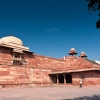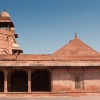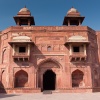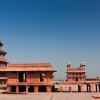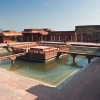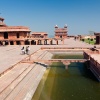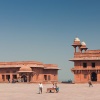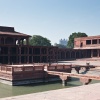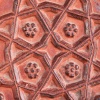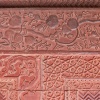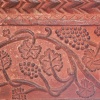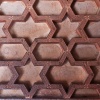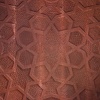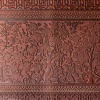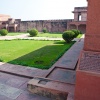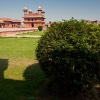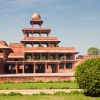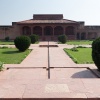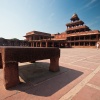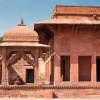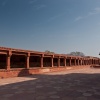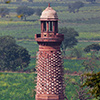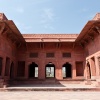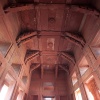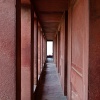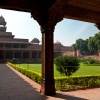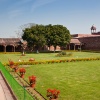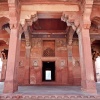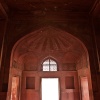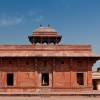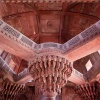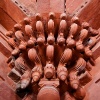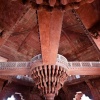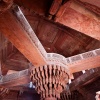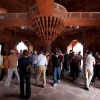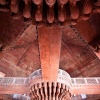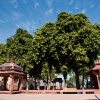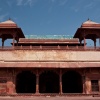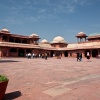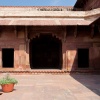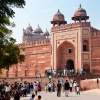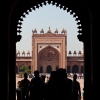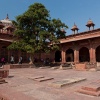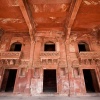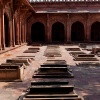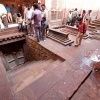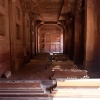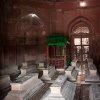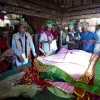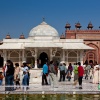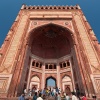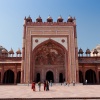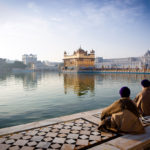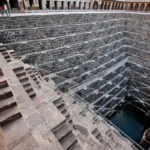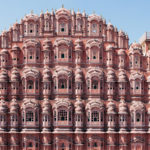Fatehpur Sikri – Ghost Town of the Great Moguls
Being located just an hour drive away from world famous Taj Mahal, the town of Fatehpur Sikri is providing an in-depth insight into India’s history as from 1571 to 1585 it has been the capital of Great Mogul Akbar’s empire. Quite a long time ago, though its buildings and chambers are looking still like as its inhabitants were checking out yesterday only. Actually the complex of ancient buildings consists of two cities, which is the holy town Fatehpur and the royal enclosure Sikri. Nowadays tourists are walking awe-inspired over mosaics set in red sand stone and white marble of highest quality.
Usually the guides are starting their tour in Sikri, following the course anti-clockwise. First eye-catcher of the inner yard is the ornamental pool, where diverse dances had once been held while Great Mogul Akbar was sitting together with his ministers in a pavilion just above the pool (Daulat Khana) watching all things going on.
The path leads further on to Rumi Sultana, the palace for Akbar’s Turkish Muslim wife. The tiny building is the most ornamented and decorated one of the entire royal enclosures as there is no place left without a very fine structure and picture carved in stone. Sunlight shining into this palace must have caused very interesting colour effects when illuminating the jewels once stored there. Not far away and located at the outer eastern wall you can find Diwan-i-Am, Akbar’s courtyard.
Before you’ll surely stumble upon the massive seat set in stone that is part of the Pachisi yard where the Pachisi game was playing involving female slaves. The five storey Panch Mahal seems to belong to Pachisi yard as well, but is a palace of its own. It is decreasing in size until the top consists of one tiny kiosk only. The structure is supported by 84 differently shaped columns in the ground level.
Diwan-i-Khas, the hall for public hearings, is directly connecting to the Pachisi yard. From outside the building looks a little unspectacular, but the inside is a Mecca for all wide angle fans as a massive stone column having magnificently carvings at the top is dominating the room.
The rear part of the Sikri mansion allows you to have a look at the elephant tower Haran Minar. This 21 meters high tower is decorated with stone made elephant tusks all over. It is located over the tomb of Akbar’s most loved elephant, an animal having an extra-ordinary intelligence, says the legend. A look over the walls of Sikri also reveals the ruins of the former hammam as well as the Caravanserai.
The tour then continues to the treasury that is housing secret stone safes hewn into stone. No arm in the world could reach the bottom of those safes but only Great Mogul Akbar’s tool, which helped him to get items from the ground back into his hands.
When you leave the treasury to the right you will walk into the Ladies Garden that is not far away from the garden of the summer house. The summer house is part of the Jodh Bai Palace, which logically also consists of a winter house and whose entrance is right behind the main ticket office. While the summer house is breezy due to having many windows and pointing to the North, the winter house has no windows at all and its southern wall is absorbing the sun energy. This palace is melting architectural elements such as classic Indian columns as well as Islamic domes and turquoise blue Persian roof tiles.
In opposite to Sikri admission fee has to be paid when entering Fatehpur. After surviving the walk through an army of junk selling people, you will see an outstanding mosque built in Rajput-Persian style. Its spiritual centre is the white marble mausoleum for Sheik Salim Chishti. When entering the yard coming from Sikri you will walk through the royal gate (Shahi Darwaza). Though, the southern gate or Victory Gate (Buland Darwaza) for the ordinary people is much more spectacular as it is 54 metres high.
Sheik Salim Chishti is a prophet once forecasting to Akbar the birth of a son, the dynasty’s successor. Even today lots of Indian people are going on a pilgrimage to visit this temple. Before entering the mausoleum they buy a whatsoever styled cloth to throw it over the tomb while spreading rose flower leaves over it. After that you’re allowed to knot a cord to one of the three doors doing three windings. Every winding is symbolising a wish of your choice.
On the northern side, between royal gate and the mausoleum the grave yard can be found. There all relatives of the Great Moguls dynasty are resting in peace. Not far away an inconspicuous door to the underground can be found. This is the start of a secret 45km long underground escape tube leading to the Fort of Agra.

